
5079-4


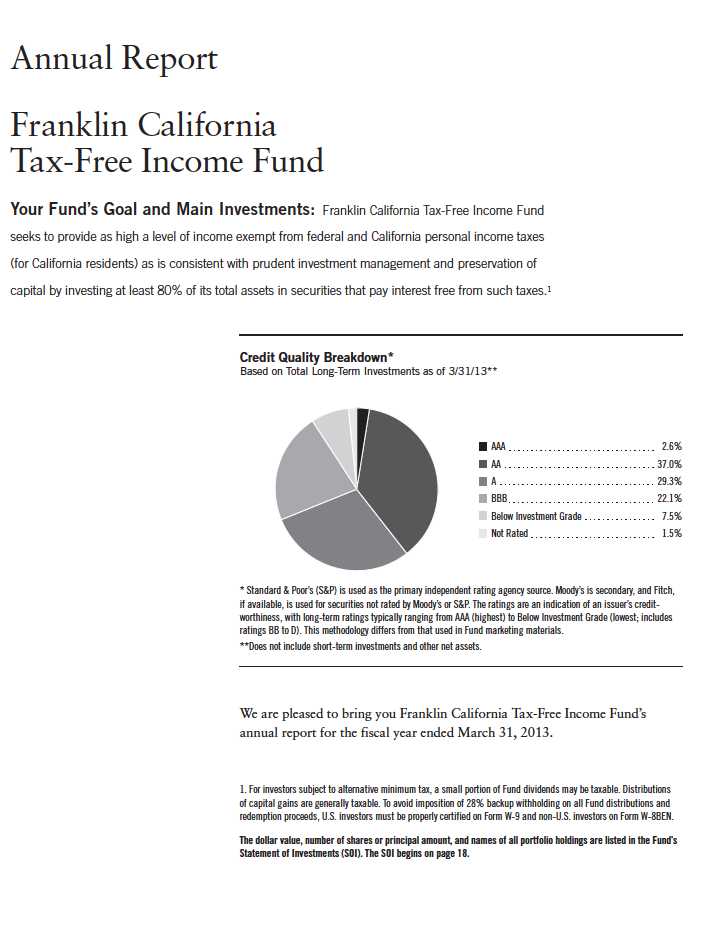
4 | Annual Report

Annual Report | 5
growth. California’s 9.4% unemployment rate in March remained well above the 7.6% national rate, but the state’s pace of job creation surpassed the nation’s during much of the period.3 The construction sector and professional and business services sector grew over 12 months, as did most employment sectors.
California’s governor presented a structurally balanced budget proposal in January, reflective of the state’s improving credit quality and economic recovery. Earlier in the reporting period, lawmakers enacted an on-time fiscal year 2013 budget that closed a sizable gap through recurring and one-time spending cuts, temporary taxes and other actions while rebuilding the reserve. The enacted budget required the passage of Proposition 30, an initiative calling for increased income taxes for high-income earners for five years and a temporary increase to the sales tax, with additional revenues dedicated solely to funding education. Voters passed Proposition 30 in November 2012, raising California’s revenue base and avoiding $6 billion in automatic spending cuts to education and public safety. This improved budget situation prompted lawmakers to project a surplus by fiscal year 2014, based on the assumption that future expenditures would grow less rapidly than revenues. Near period-end, lawmakers announced that revenues collected in January 2013 exceeded expectations, reversing disappointing tax revenues at the end of 2012 and indicative of the challenge of the state’s revenue volatility. Also in January, California issued $2 billion in general obligation bonds to finance capital and infrastructure projects and to refund some existing general obligation bonds.
The state’s net tax-supported debt was $2,559 per capita and 6.0% of personal income, compared with the $1,117 and 2.8% national medians.4 Although California’s debt levels ranked among the nation’s highest, independent credit rating agency Standard & Poor’s (S&P) considered them moderate given the state’s large population and budget. S&P raised California’s general obligation bond rating to A from A- during the period, with a stable outlook.5 S&P’s rating and outlook reflected the state’s economic depth and diversity, capacity to attract venture capital, significant presence of the growing biotechnology and alternative energy industries, prominent higher education institutions, innovative businesses, improved budgeting flexibility and cash performance, as well as conservatively structured debt. S&P attributed the stable outlook to the state’s stronger budgetary and cash positions and to the fiscal year 2014 budget proposal to pay down some of the state’s liabilities.
3. Source: Bureau of Labor Statistics.
4. Source: Moody’s Investors Service, “Median Report: 2012 State Debt Medians Report,” 5/22/12.
5. This does not indicate S&P’s rating of the Fund.
6 | Annual Report
Municipal Bond Market Overview
For the 12-month period ended March 31, 2013, the municipal bond market produced solid returns. During this period, the Barclays Municipal Bond Index, which tracks investment-grade municipal securities, returned +5.25%.6 In comparison, the Barclays U.S. Treasury Index returned +3.14%.6 The tax-exempt nature of most municipal bond coupon payments included in the Barclays Municipal Bond Index further enhanced the relative strength of municipal bond performance for the period under review.
The municipal market delivered positive performance even though Moody’s Investors Service, S&P and Fitch, the three largest independent municipal bond rating agencies, lowered credit ratings of several municipalities during the review period. In 2012, the agencies collectively issued 1,469 downgrades to 838 upgrades. S&P was the only firm to boost more ratings than it downgraded, whereas Moody’s was the most aggressive, cutting 824 ratings while upgrading 187. Some of the more noteworthy downgrades over the past 12 months included Connecticut, Illinois, Pennsylvania and Puerto Rico. Despite the high number of downgrades during 2012, actual monetary defaults amounted to $2.7 billion, or 0.072% of issues.7 Low default rates have been a characteristic of the municipal bond market since the Great Depression ended.
During the period, investors continued to buy municipal bonds and bond funds at a strong pace. According to the Investment Company Institute, investors committed $49.6 billion in new net purchases to municipal bond funds.8 Concurrent with investors’ appetite for municipal bonds, municipalities throughout the country borrowed for new purposes at the slowest rate since 1997. Strong demand for municipal bonds coupled with low supply drove the municipal market’s positive performance.
Federal Reserve Board (Fed) Chairman Ben Bernanke testified before the Senate Banking Committee on February 26, 2013, and reaffirmed the Fed’s commitment to keeping interest rates low. One of the Fed’s tools used to maintain low rates is the purchase of government and governmental agency debt in the secondary market. The Fed indicated it will maintain its bond-buying strategy “until the outlook for the labor markets has improved substantially.” This continued strategy could help support further demand for municipal bonds.
6. Source: © 2013 Morningstar. All Rights Reserved. The information contained herein: (1) is proprietary to Morningstar and/or its content providers; (2) may not be copied or distributed; and (3) is not warranted to be accurate, complete or timely. Neither Morningstar nor its content providers are responsible for any damages or losses arising from any use of this information.
7. Source: BofA Merrill Lynch Global Research, “Muni Commentary: Monetary and Fiscal Policy in Flux,” 1/4/13.
8. Source: Investment Company Institute, Washington, DC 2013.
Annual Report | 7


*Does not include short-term investments and other net assets.
After the November elections, discussions about ways to achieve deficit reduction included possibly changing municipal bonds’ tax-exempt status. Investor nervousness about such changes prompted outflows from municipal bond mutual funds in December that reached the highest weekly level since January 2011, according to Lipper Inc. Municipal bond prices fell and their yields rose near the end of 2012. Late on January 1, 2013, Congress agreed to raise income taxes on the wealthiest Americans and defer some federal spending cuts. The bill did not include changes to municipal bonds’ tax-exempt status.
At period-end, we maintained our positive view of the municipal bond market. We believe municipal bonds continue to be an attractive asset class among fixed income securities, and we intend to follow our solid discipline of investing to maximize income while seeking value in the municipal bond market.
Investment Strategy
We use a consistent, disciplined strategy in an effort to maximize tax-exempt income for our shareholders while balancing risk and return within the Fund’s range of allowable investments. We generally employ a buy-and-hold approach and invest in securities we believe should provide the most relative value in the market. We do not use leverage or exotic derivatives, nor do we use hedging techniques that could add volatility and contribute to underperformance in adverse markets. We generally seek to stay close to fully invested to help maximize income distribution.
Manager’s Discussion
Based on the combination of our value-oriented philosophy of investing primarily for income and a positive-sloping municipal yield curve, we favored the use of longer term bonds. Consistent with our strategy, we sought to purchase bonds that ranged from 15 to 30 years in maturity with good call features. We believe our conservative, buy-and-hold investment strategy can help us achieve relatively high, current, tax-free income for shareholders.
Thank you for your participation in Franklin California Tax-Free Income Fund. We look forward to serving your future investment needs.
The foregoing information reflects our analysis, opinions and portfolio holdings as of March 31, 2013, the end of the reporting period. The way we implement our main investment strategies and the resulting portfolio holdings may change depending on factors such as market and economic conditions. These opinions may not be relied upon as investment advice or an offer for a particular security. The information is not a complete analysis of every aspect of any market, state, industry, security or the Fund. Statements of fact are from sources considered reliable, but the investment manager makes no representation or warranty as to their completeness or accuracy. Although historical performance is no guarantee of future results, these insights may help you understand our investment management philosophy.
8 | Annual Report
Performance Summary as of 3/31/13
Your dividend income will vary depending on dividends or interest paid by securities in the Fund’s portfolio, adjusted for operating expenses of each class. Capital gain distributions are net profits realized from the sale of portfolio securities. The performance table and graphs do not reflect any taxes that a shareholder would pay on Fund dividends, capital gain distributions, if any, or any realized gains on the sale of Fund shares. Total return reflects reinvestment of the Fund’s dividends and capital gain distributions, if any, and any unrealized gains or losses.

Annual Report | 9

10 | Annual Report
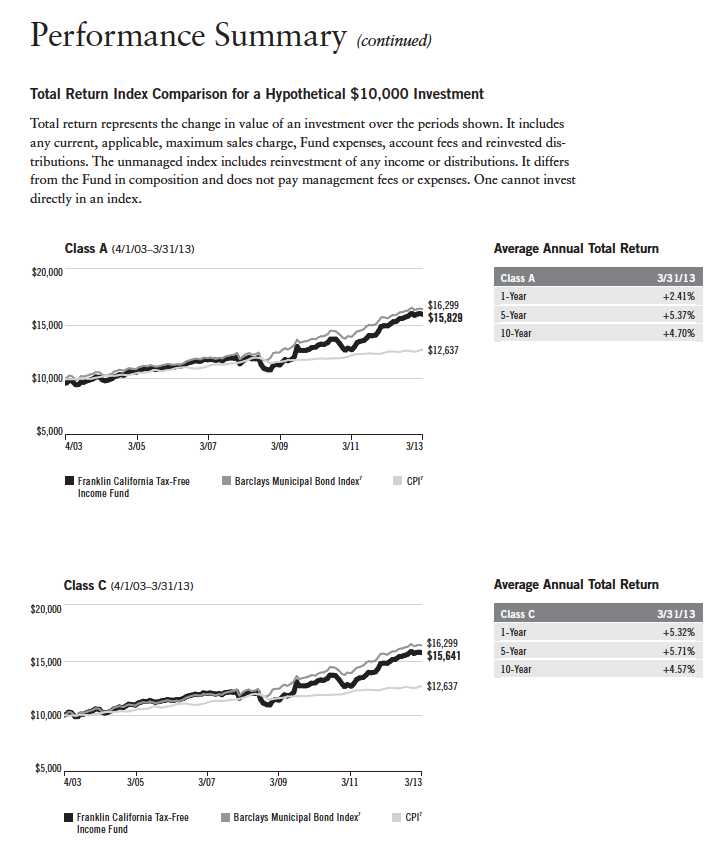
Annual Report | 11

12 | Annual Report
Your Fund’s Expenses
As a Fund shareholder, you can incur two types of costs:
- Transaction costs, including sales charges (loads) on Fund purchases; and
- Ongoing Fund costs, including management fees, distribution and service (12b-1) fees, and other Fund expenses. All mutual funds have ongoing costs, sometimes referred to as operating expenses.
The following table shows ongoing costs of investing in the Fund and can help you understand these costs and compare them with those of other mutual funds. The table assumes a $1,000 investment held for the six months indicated.
Actual Fund Expenses
The first line (Actual) for each share class listed in the table provides actual account values and expenses. The “Ending Account Value” is derived from the Fund’s actual return, which includes the effect of Fund expenses.
You can estimate the expenses you paid during the period by following these steps. Of course, your account value and expenses will differ from those in this illustration:
| 1. | Divide your account value by $1,000. |
| If an account had an $8,600 value, then $8,600 ÷ $1,000 = 8.6. | |
| 2. | Multiply the result by the number under the heading “Expenses Paid During Period.” |
| If Expenses Paid During Period were $7.50, then 8.6 x $7.50 = $64.50. |
In this illustration, the estimated expenses paid this period are $64.50.
Hypothetical Example for Comparison with Other Funds
Information in the second line (Hypothetical) for each class in the table can help you compare ongoing costs of investing in the Fund with those of other mutual funds. This information may not be used to estimate the actual ending account balance or expenses you paid during the period. The hypothetical “Ending Account Value” is based on the actual expense ratio for each class and an assumed 5% annual rate of return before expenses, which does not represent the Fund’s actual return. The figure under the heading “Expenses Paid During Period” shows the hypothetical expenses your account would have incurred under this scenario. You can compare this figure with the 5% hypothetical examples that appear in shareholder reports of other funds.
Annual Report | 13
Your Fund’s Expenses (continued)
Please note that expenses shown in the table are meant to highlight ongoing costs and do not reflect any transaction costs, such as sales charges. Therefore, the second line for each class is useful in comparing ongoing costs only, and will not help you compare total costs of owning different funds. In addition, if transaction costs were included, your total costs would have been higher. Please refer to the Fund prospectus for additional information on operating expenses.
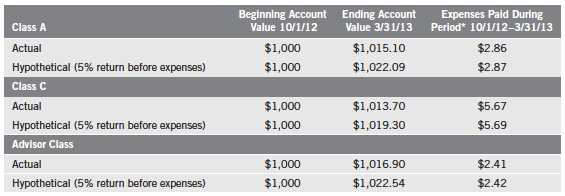
*Expenses are calculated using the most recent six-month expense ratio, annualized for each class (A: 0.57%; C: 1.13%; and Advisor: 0.48%), multiplied by the average account value over the period, multiplied by 182/365 to reflect the one-half year period.
14 | Annual Report
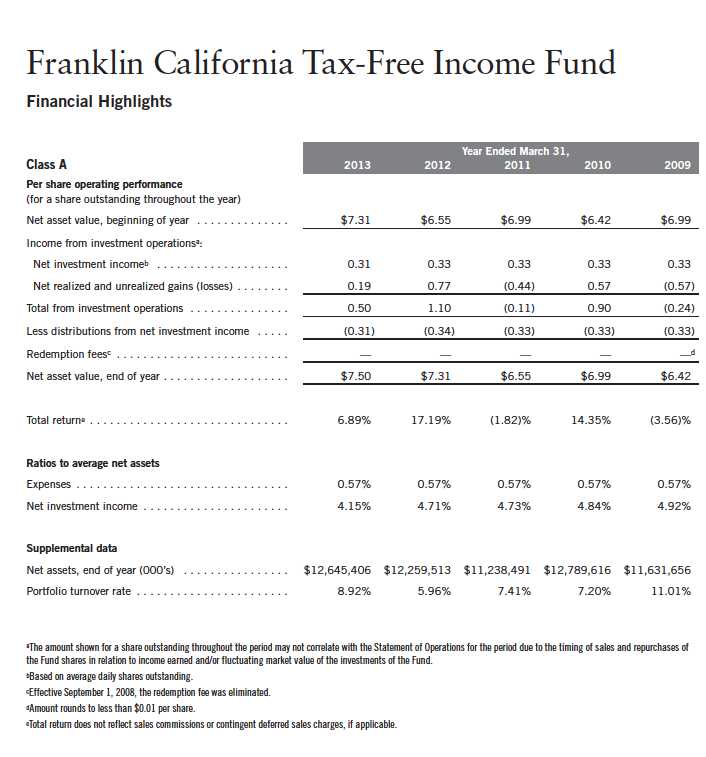
Annual Report | The accompanying notes are an integral part of these financial statements. | 15

16 | The accompanying notes are an integral part of these financial statements. | Annual Report

Annual Report | The accompanying notes are an integral part of these financial statements. | 17
Franklin California Tax-Free Income Fund
Statement of Investments, March 31, 2013

18 | Annual Report
Franklin California Tax-Free Income Fund
Statement of Investments, March 31, 2013 (continued)

Annual Report | 19
Franklin California Tax-Free Income Fund
Statement of Investments, March 31, 2013 (continued)
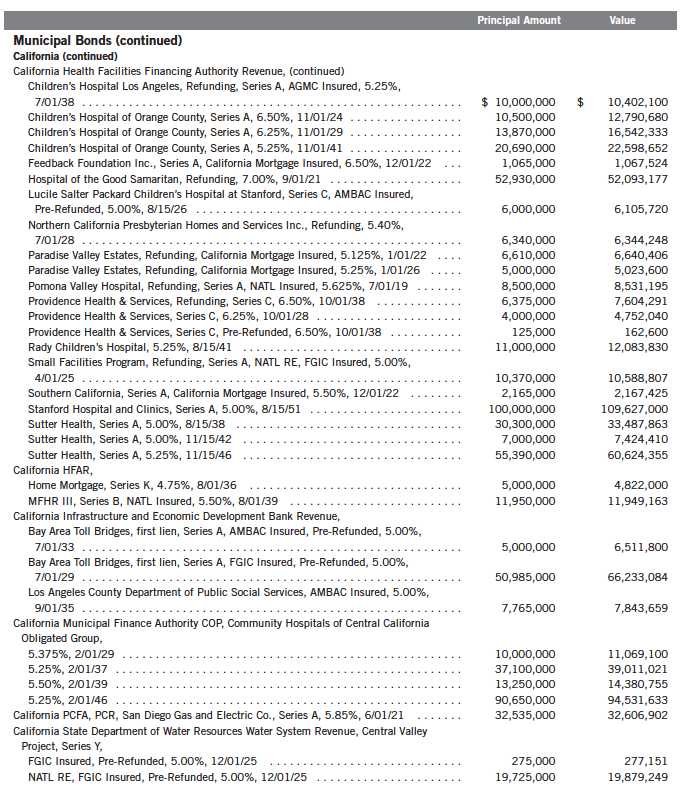
20 | Annual Report
Franklin California Tax-Free Income Fund
Statement of Investments, March 31, 2013 (continued)

Annual Report | 21
Franklin California Tax-Free Income Fund
Statement of Investments, March 31, 2013 (continued)
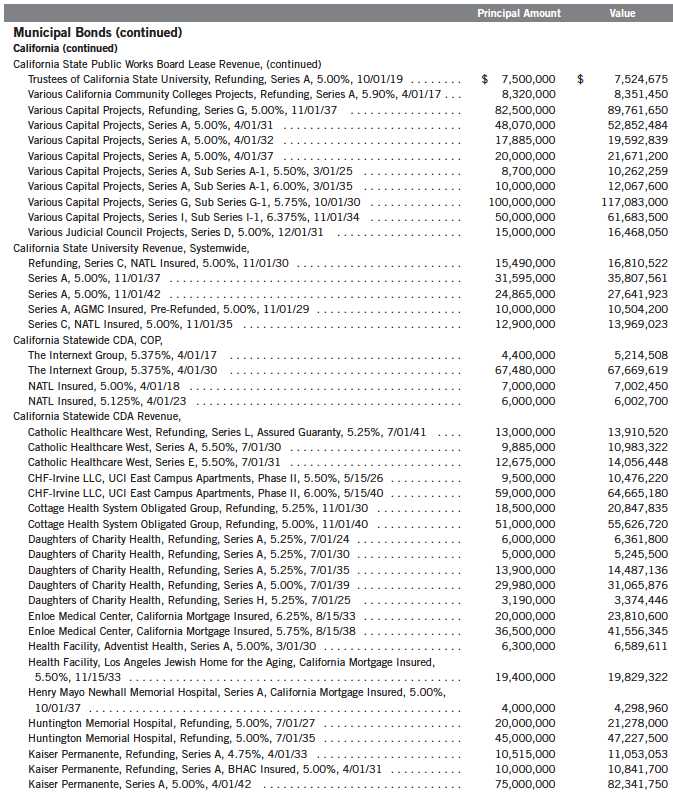
22 | Annual Report
Franklin California Tax-Free Income Fund
Statement of Investments, March 31, 2013 (continued)

Annual Report | 23
Franklin California Tax-Free Income Fund
Statement of Investments, March 31, 2013 (continued)

24 | Annual Report
Franklin California Tax-Free Income Fund
Statement of Investments, March 31, 2013 (continued)

Annual Report | 25
Franklin California Tax-Free Income Fund
Statement of Investments, March 31, 2013 (continued)

26 | Annual Report
Franklin California Tax-Free Income Fund
Statement of Investments, March 31, 2013 (continued)

Annual Report | 27
Franklin California Tax-Free Income Fund
Statement of Investments, March 31, 2013 (continued)

28 | Annual Report
Franklin California Tax-Free Income Fund
Statement of Investments, March 31, 2013 (continued)

Annual Report | 29
Franklin California Tax-Free Income Fund
Statement of Investments, March 31, 2013 (continued)

30 | Annual Report
Franklin California Tax-Free Income Fund
Statement of Investments, March 31, 2013 (continued)
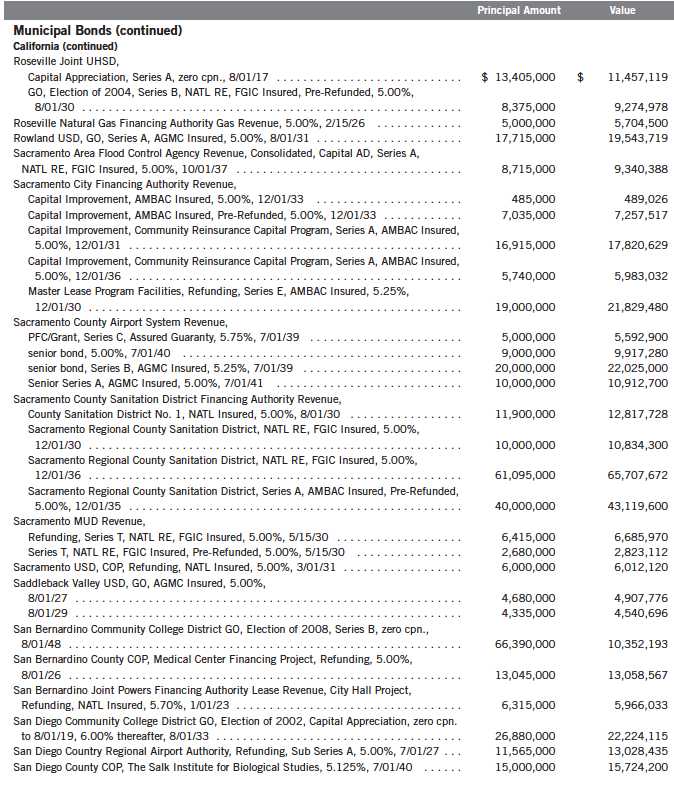
Annual Report | 31
Franklin California Tax-Free Income Fund
Statement of Investments, March 31, 2013 (continued)

32 | Annual Report
Franklin California Tax-Free Income Fund
Statement of Investments, March 31, 2013 (continued)

Annual Report | 33
Franklin California Tax-Free Income Fund
Statement of Investments, March 31, 2013 (continued)

34 | Annual Report
Franklin California Tax-Free Income Fund
Statement of Investments, March 31, 2013 (continued)

Annual Report | 35
Franklin California Tax-Free Income Fund
Statement of Investments, March 31, 2013 (continued)
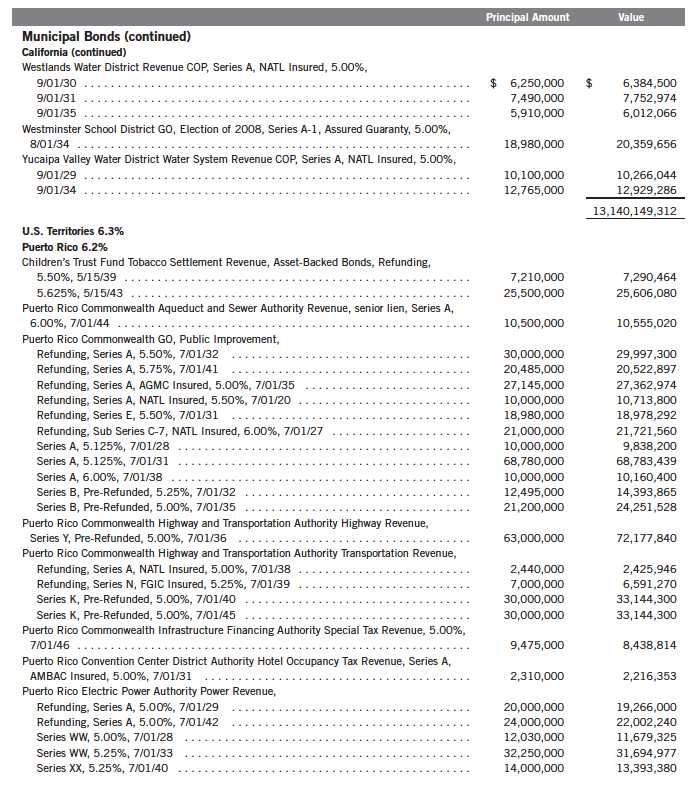
36 | Annual Report
Franklin California Tax-Free Income Fund
Statement of Investments, March 31, 2013 (continued)

Annual Report | 37

38 | The accompanying notes are an integral part of these financial statements. | Annual Report
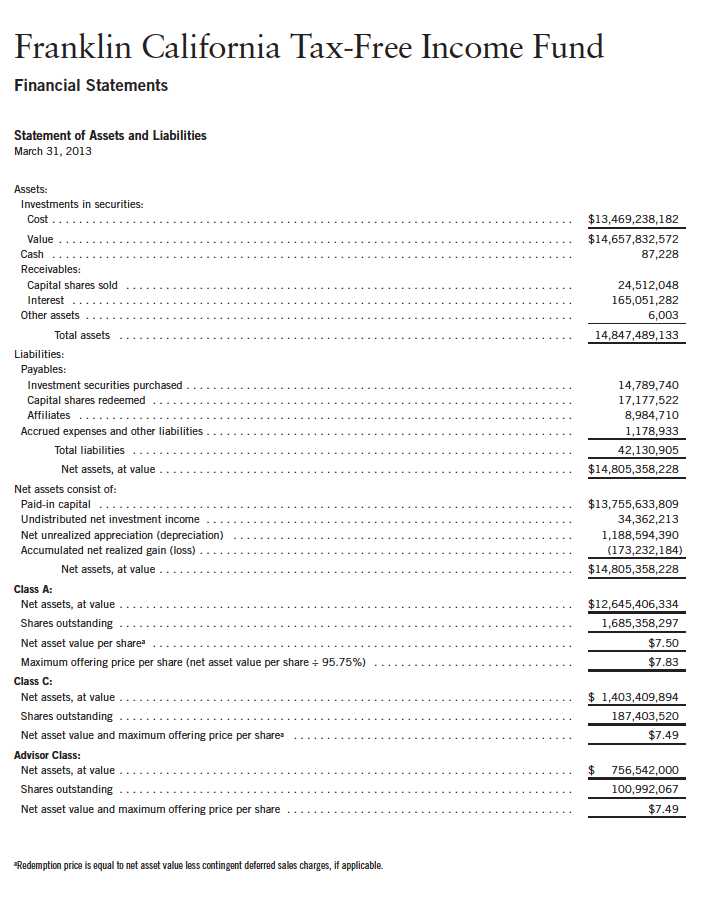
Annual Report | The accompanying notes are an integral part of these financial statements. | 39
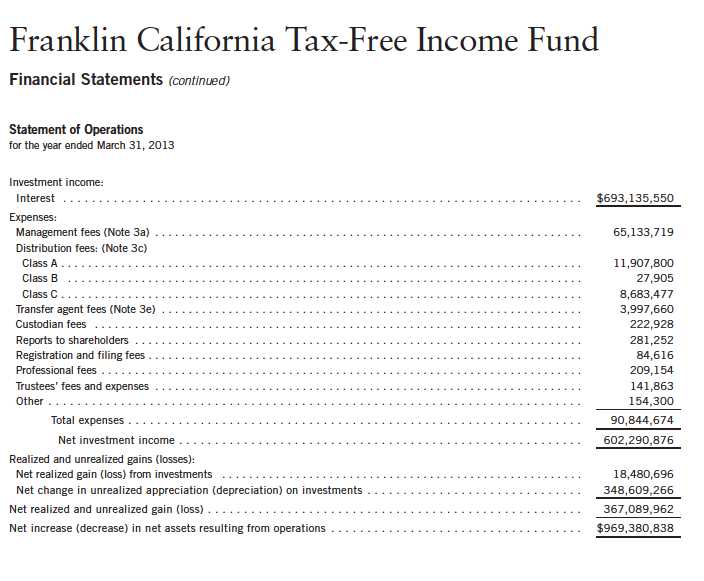
40 | The accompanying notes are an integral part of these financial statements. | Annual Report
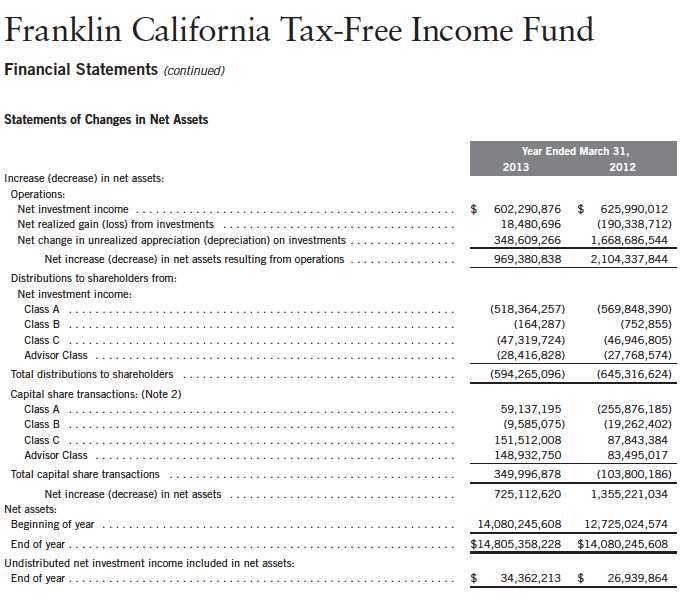
Annual Report | The accompanying notes are an integral part of these financial statements. | 41
Franklin California Tax-Free Income Fund
Notes to Financial Statements
1. ORGANIZATION AND SIGNIFICANT ACCOUNTING POLICIES
Franklin California Tax-Free Income Fund (Fund) is registered under the Investment Company Act of 1940, as amended, (1940 Act) as an open-end investment company. The Fund offers three classes of shares: Class A, Class C, and Advisor Class. Effective March 5, 2013, all class B shares were converted to class A. Each class of shares differs by its initial sales load, contingent deferred sales charges, distribution fees, voting rights on matters affecting a single class, its exchange privilege and fees primarily due to differing arrangements for distribution and transfer agent fees.
The following summarizes the Fund’s significant accounting policies.
a. Financial Instrument Valuation
The Fund’s investments in financial instruments are carried at fair value daily. Fair value is the price that would be received to sell an asset or paid to transfer a liability in an orderly transaction between market participants on the measurement date. Under procedures approved by the Fund’s Board of Trustees (the Board), the Fund’s administrator, investment manager and other affiliates have formed the Valuation and Liquidity Oversight Committee (VLOC). The VLOC provides administration and oversight of the Fund’s valuation policies and procedures, which are approved annually by the Board. Among other things, these procedures allow the Fund to utilize independent pricing services, quotations from securities and financial instrument dealers, and other market sources to determine fair value.
Debt securities generally trade in the over-the-counter market rather than on a securities exchange. The Fund’s pricing services use multiple valuation techniques to determine fair value. In instances where sufficient market activity exists, the pricing services may utilize a market-based approach through which quotes from market makers are used to determine fair value. In instances where sufficient market activity may not exist or is limited, the pricing services also utilize proprietary valuation models which may consider market characteristics such as benchmark yield curves, credit spreads, estimated default rates, anticipated market interest rate volatility, coupon rates, anticipated timing of principal repayments, underlying collateral, and other unique security features in order to estimate the relevant cash flows, which are then discounted to calculate the fair value.
The Fund has procedures to determine the fair value of financial instruments for which market prices are not reliable or readily available. Under these procedures, the VLOC convenes on a regular basis to review such financial instruments and considers a number of factors, including significant unobservable valuation inputs, when arriving at fair value. The VLOC primarily employs a market-based approach which may use related or comparable assets or liabilities, recent transactions, market multiples, book values, and other relevant information for the investment to determine the fair value of the investment. An income-based valuation approach may also be used in which the anticipated future cash flows of the investment are discounted to calculate fair value. Discounts may also be applied due to the nature or duration of any restrictions on the disposition of the investments. Due to the inherent uncertainty of valuations of such investments, the fair values may differ significantly from the values that would have been used had
42 | Annual Report
Franklin California Tax-Free Income Fund
Notes to Financial Statements (continued)
| 1. | ORGANIZATION AND SIGNIFICANT ACCOUNTING POLICIES (continued) |
| a. | Financial Instrument Valuation (continued) |
an active market existed. The VLOC employs various methods for calibrating these valuation approaches including a regular review of key inputs and assumptions, transactional back-testing or disposition analysis, and reviews of any related market activity.
b. Securities Purchased on a When-Issued Basis
The Fund purchases securities on a when-issued basis, with payment and delivery scheduled for a future date. These transactions are subject to market fluctuations and are subject to the risk that the value at delivery may be more or less than the trade date purchase price. Although the Fund will generally purchase these securities with the intention of holding the securities, it may sell the securities before the settlement date. Sufficient assets have been segregated for these securities.
c. Income Taxes
It is the Fund’s policy to qualify as a regulated investment company under the Internal Revenue Code. The Fund intends to distribute to shareholders substantially all of its income and net realized gains to relieve it from federal income and excise taxes. As a result, no provision for U.S. federal income taxes is required.
The Fund recognizes the tax benefits of uncertain tax positions only when the position is “more likely than not” to be sustained upon examination by the tax authorities based on the technical merits of the tax position. As of March 31, 2013, and for all open tax years, the Fund has determined that no liability for unrecognized tax benefits is required in the Fund’s financial statements related to uncertain tax positions taken on a tax return (or expected to be taken on future tax returns). Open tax years are those that remain subject to examination and are based on each tax jurisdiction statute of limitation.
d. Security Transactions, Investment Income, Expenses and Distributions
Security transactions are accounted for on trade date. Realized gains and losses on security transactions are determined on a specific identification basis. Interest income and estimated expenses are accrued daily. Amortization of premium and accretion of discount on debt securities are included in interest income. Distributions to shareholders are recorded on the ex-dividend date and are determined according to income tax regulations (tax basis). Distributable earnings determined on a tax basis may differ from earnings recorded in accordance with accounting principles generally accepted in the United States of America. These differences may be permanent or temporary. Permanent differences are reclassified among capital accounts to reflect their tax character. These reclassifications have no impact on net assets or the results of operations. Temporary differences are not reclassified, as they may reverse in subsequent periods.
Realized and unrealized gains and losses and net investment income, not including class specific expenses, are allocated daily to each class of shares based upon the relative proportion of net assets of each class. Differences in per share distributions, by class, are generally due to differences in class specific expenses.
Annual Report | 43
Franklin California Tax-Free Income Fund
Notes to Financial Statements (continued)
| 1. | ORGANIZATION AND SIGNIFICANT ACCOUNTING POLICIES (continued) |
| e. | Insurance |
The scheduled payments of interest and principal for each insured municipal security in the Fund are insured by either a new issue insurance policy or a secondary insurance policy. Some municipal securities in the Fund are secured by collateral guaranteed by an agency of the U.S. government. Depending on the type of coverage, premiums for insurance are either added to the cost basis of the security or paid by a third party.
Insurance companies typically insure municipal bonds that tend to be of very high quality, with the majority of underlying municipal bonds rated A or better. However, an event involving an insurer could have an adverse effect on the value of the securities insured by that insurance company. There is no guarantee the insurer will be able to fulfill its obligations under the terms of the policy.
f. Accounting Estimates
The preparation of financial statements in accordance with accounting principles generally accepted in the United States of America requires management to make estimates and assumptions that affect the reported amounts of assets and liabilities at the date of the financial statements and the amounts of income and expenses during the reporting period. Actual results could differ from those estimates.
g. Guarantees and Indemnifications
Under the Fund’s organizational documents, its officers and trustees are indemnified by the Fund against certain liabilities arising out of the performance of their duties to the Fund. Additionally, in the normal course of business, the Fund enters into contracts with service providers that contain general indemnification clauses. The Fund’s maximum exposure under these arrangements is unknown as this would involve future claims that may be made against the Fund that have not yet occurred. Currently, the Fund expects the risk of loss to be remote.
2. SHARES OF BENEFICIAL INTEREST
At March 31, 2013, there were an unlimited number of shares authorized (without par value).
Transactions in the Fund’s shares were as follows:

44 | Annual Report

Annual Report | 45

46 | Annual Report

Annual Report | 47

48 | Annual Report
Franklin California Tax-Free Income Fund
Notes to Financial Statements (continued)
8. CREDIT FACILITY (continued)
temporary and emergency purposes, including the ability to meet future unanticipated or unusually large redemption requests.
Under the terms of the Global Credit Facility, the Fund shall, in addition to interest charged on any borrowings made by the Fund and other costs incurred by the Fund pay its share of fees and expenses incurred in connection with the implementation and maintenance of the Global Credit Facility, based upon its relative share of the aggregate net assets of all of the Borrowers, including an annual commitment fee of 0.07% based upon the unused portion of the Global Credit Facility. These fees are reflected in other expenses on the Statement of Operations. During the year ended March 31, 2013, the Fund did not use the Global Credit Facility.
9. FAIR VALUE MEASUREMENTS
The Fund follows a fair value hierarchy that distinguishes between market data obtained from independent sources (observable inputs) and the Fund’s own market assumptions (unobservable inputs). These inputs are used in determining the value of the Fund’s financial instruments and are summarized in the following fair value hierarchy:
- Level 1 – quoted prices in active markets for identical financial instruments
- Level 2 – other significant observable inputs (including quoted prices for similar financial instruments, interest rates, prepayment speed, credit risk, etc.)
- Level 3 – significant unobservable inputs (including the Fund’s own assumptions in determining the fair value of financial instruments)
The inputs or methodology used for valuing financial instruments are not an indication of the risk associated with investing in those financial instruments.
For movements between the levels within the fair value hierarchy, the Fund has adopted a policy of recognizing the transfers as of the date of the underlying event which caused the movement.
At March 31, 2013, all of the Fund’s investments in financial instruments carried at fair value were valued using Level 2 inputs.
10. SUBSEQUENT EVENTS
The Fund has evaluated subsequent events through the issuance of the financial statements and determined that no events have occurred that require disclosure.
Annual Report | 49

50 | Annual Report
Franklin California Tax-Free Income Fund
Report of Independent Registered Public Accounting Firm
To the Board of Trustees and Shareholders of Franklin California Tax-Free Income Fund
In our opinion, the accompanying statement of assets and liabilities, including the statement of investments, and the related statements of operations and of changes in net assets and the financial highlights present fairly, in all material respects, the financial position of Franklin California Tax-Free Income Fund (the “Fund”) at March 31, 2013, the results of its operations for the year then ended, the changes in its net assets for each of the two years in the period then ended and the financial highlights for each of the five years in the period then ended, in conformity with accounting principles generally accepted in the United States of America. These financial statements and financial highlights (hereafter referred to as “financial statements”) are the responsibility of the Fund’s management. Our responsibility is to express an opinion on these financial statements based on our audits. We conducted our audits of these financial statements in accordance with the standards of the Public Company Accounting Oversight Board (United States). Those standards require that we plan and perform the audit to obtain reasonable assurance about whether the financial statements are free of material misstatement. An audit includes examining, on a test basis, evidence supporting the amounts and disclosures in the financial statements, assessing the accounting principles used and significant estimates made by management, and evaluating the overall financial statement presentation. We believe that our audits, which included confirmation of securities at March 31, 2013 by correspondence with the custodian, transfer agent and brokers, provide a reasonable basis for our opinion.
PricewaterhouseCoopers LLP
San Francisco, California
May 22, 2013
Annual Report | 51
Franklin California Tax-Free Income Fund
Tax Information (unaudited)
Under Section 852(b)(5)(A) of the Internal Revenue Code, the Fund hereby report 100% of the distributions paid from net investment income as exempt-interest dividends for the fiscal year ended March 31, 2013. A portion of the Fund’s exempt-interest dividends may be subject to the federal alternative minimum tax. By mid-February 2014, shareholders will be notified of amounts for use in preparing their 2013 income tax returns.
52 | Annual Report

Annual Report | 53
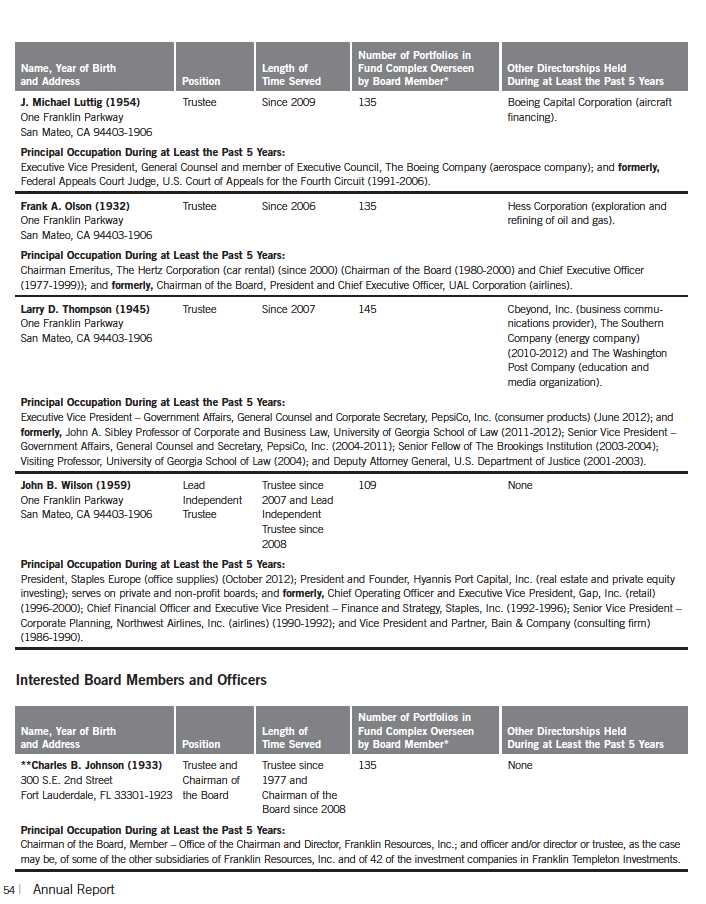

Annual Report | 55
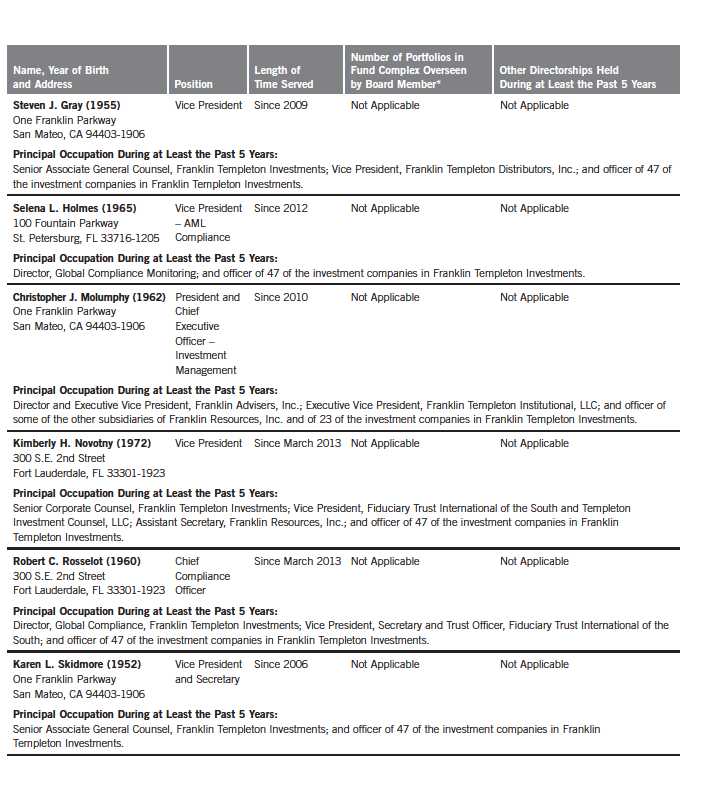
56 | Annual Report
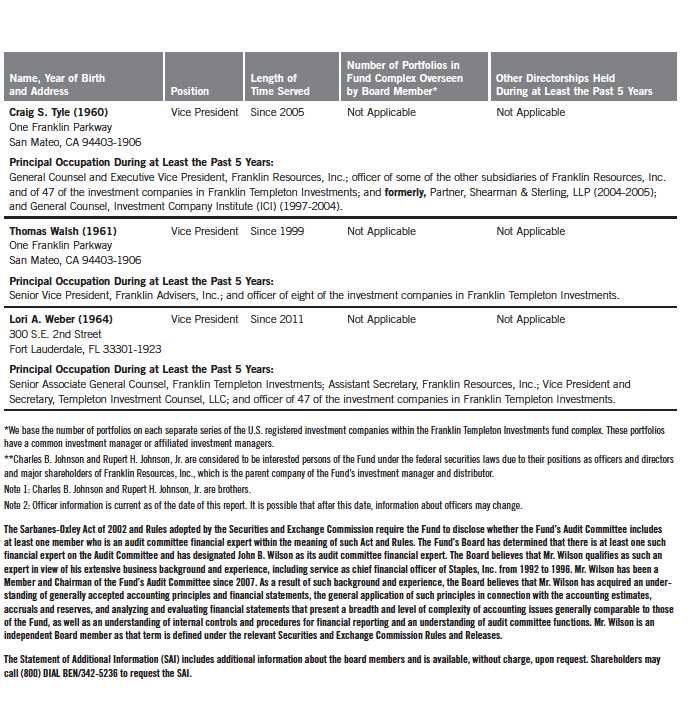
Annual Report | 57
Franklin California Tax-Free Income Fund
Shareholder Information
Board Review of Investment Management Agreement
At a meeting held February 26, 2013, the Board of Trustees (Board), including a majority of non-interested or independent Trustees, approved renewal of the investment management agreement for the Fund. In reaching this decision, the Board took into account information furnished throughout the year at regular Board meetings, as well as information prepared specifically in connection with the annual renewal review process. Information furnished and discussed throughout the year included investment performance reports and related financial information for the Fund, along with periodic reports on expenses, shareholder services, legal and compliance matters, pricing, and other services provided by the Investment Manager (Manager) and its affiliates, as well as a third-party survey of transfer agent fees charged funds within the Franklin Templeton Investments complex in comparison with those charged other fund complexes deemed comparable. Information furnished specifically in connection with the renewal process included a report for the Fund prepared by Lipper, Inc. (Lipper), an independent organization, as well as additional material, including a Fund profitability analysis prepared by management. The Lipper report compared the Fund’s investment performance and expenses with those of other mutual funds deemed comparable to the Fund as selected by Lipper. The Fund profitability analysis discussed the profitability to Franklin Templeton Investments from its overall U.S. fund operations, as well as on an individual fund-by-fund basis. Additional material accompanying such profitability analysis included information on a fund-by-fund basis listing portfolio managers and other accounts they manage, as well as information on management fees charged by the Manager and its affiliates to U.S. mutual funds and other accounts, including management’s explanation of differences where relevant. Such material also included a memorandum prepared by management describing project initiatives and capital investments relating to the services provided to the Fund by the Franklin Templeton Investments organization, as well as a memorandum relating to economies of scale and an analysis concerning transfer agent fees charged by an affiliate of the Manager.
In considering such materials, the independent Trustees received assistance and advice from and met separately with independent counsel. In approving continuance of the investment management agreement for the Fund, the Board, including a majority of independent Trustees, determined that the existing management fee structure was fair and reasonable and that continuance of the investment management agreement was in the best interests of the Fund and its shareholders. While attention was given to all information furnished, the following discusses some primary factors relevant to the Board’s decision.
NATURE, EXTENT AND QUALITY OF SERVICES. The Board was satisfied with the nature and quality of the overall services provided by the Manager and its affiliates to the Fund and its shareholders. In addition to investment performance and expenses discussed later, the Board’s opinion was based, in part, upon periodic reports furnished it showing that the investment policies and restrictions for the Fund were consistently complied with as well as other reports periodically furnished the Board covering matters such as the compliance of portfolio managers and other management personnel with the code of ethics adopted throughout the Franklin Templeton fund complex, the adherence to fair value pricing procedures established by the Board, and the accuracy
58 | Annual Report
Franklin California Tax-Free Income Fund
Shareholder Information (continued)
Board Review of Investment Management Agreement (continued)
of net asset value calculations. The Board also noted the extent of benefits provided Fund shareholders from being part of the Franklin Templeton family of funds, including the right to exchange investments between the same class of funds without a sales charge, the ability to reinvest Fund dividends into other funds and the right to combine holdings in other funds to obtain a reduced sales charge. Favorable consideration was given to management’s continuous efforts and expenditures in establishing back-up systems and recovery procedures to function in the event of a natural disaster, it being noted that such systems and procedures had functioned well during the Florida hurricanes and blackouts experienced in previous years, and that those operations in the New York/New Jersey area ran smoothly during the more recent Hurricane Sandy. Consideration was also given to the experience of the Fund’s portfolio management team, the number of accounts managed and general method of compensation. In this latter respect, the Board noted that a primary factor in management’s determination of a portfolio manager’s bonus compensation was the relative investment performance of the funds he or she managed and that a portion of such bonus was required to be invested in a predesignated list of funds within such person’s fund management area so as to be aligned with the interests of shareholders. The Board also took into account the quality of transfer agent and shareholder services provided Fund shareholders by an affiliate of the Manager and the continuous enhancements to the Franklin Templeton website. Particular attention was given to management’s conservative approach and diligent risk management procedures, including continuous monitoring of counterparty credit risk and attention given to derivatives and other complex instruments. The Board also took into account, among other things, management’s efforts in establishing a global credit facility for the benefit of the Fund and other accounts managed by Franklin Templeton Investments to provide a source of cash for temporary and emergency purposes or to meet unusual redemption requests as well as the strong financial position of the Manager’s parent company and its commitment to the mutual fund business as evidenced by its subsidization of money market funds.
INVESTMENT PERFORMANCE. The Board placed significant emphasis on the investment performance of the Fund in view of its importance to shareholders. While consideration was given to performance reports and discussions with portfolio managers at Board meetings during the year, particular attention in assessing such performance was given to the Lipper report furnished for the agreement renewal. The Lipper report prepared for the Fund showed the investment performance of its Class A shares for the one year ended December 31, 2012, as well as the previous 10 years ended that date in comparison to a performance universe consisting of the Fund and all retail and institutional California municipal debt funds as selected by Lipper. The Lipper report showed the Fund’s income return for the one-year period to be in the highest or best performing quintile of its performance universe and on an annualized basis to also be in the highest or best performing quin-tile of such universe for each of the previous three-, five- and 10-year periods. The Lipper report showed the Fund’s total return for the one-year period to be in the second-highest performing quintile of its Lipper performance universe, and on an annualized basis to be in either the highest or second-highest performing quintile of such universe for the previous three-, five- and 10-year periods. The Board expressed its satisfaction with the Fund’s comparative performance as shown in the Lipper report.
Annual Report | 59
Franklin California Tax-Free Income Fund
Shareholder Information (continued)
Board Review of Investment Management Agreement (continued)
COMPARATIVE EXPENSES. Consideration was given to a comparative analysis of the management fees and total expense ratio of the Fund compared with those of a group of other funds selected by Lipper as its appropriate Lipper expense group. Lipper expense data is based upon information taken from each fund’s most recent annual report, which reflects historical asset levels that may be quite different from those currently existing, particularly in a period of market volatility. While recognizing such inherent limitation and the fact that expense ratios generally increase as assets decline and decrease as assets grow, the Board believed the independent analysis conducted by Lipper to be an appropriate measure of comparative expenses. In reviewing comparative costs, Lipper provides information on the Fund’s contractual management fee in comparison with the contractual investment management fee that would have been charged by other funds within its Lipper expense group assuming they were similar in size to the Fund, as well as the actual total expense ratio of the Fund in comparison with those of its Lipper expense group. The Lipper contractual investment management fee analysis includes administrative charges as being part of a management fee, and total expenses, for comparative consistency, are shown by Lipper for Fund Class A shares. The results of such expense comparisons showed the Fund’s contractual investment management fee rate to be within 5 basis points of its Lipper expense group median, and its actual total expense ratio to be in the least expensive quintile of such expense group. The Board was satisfied with the expenses of the Fund in comparison to those of its Lipper expense group as shown in the Lipper report.
MANAGEMENT PROFITABILITY. The Board also considered the level of profits realized by the Manager and its affiliates in connection with the operation of the Fund. In this respect, the Board reviewed the Fund profitability analysis that addresses the overall profitability of Franklin Templeton’s U.S. fund business, as well as its profits in providing management and other services to each of the individual funds during the 12-month period ended September 30, 2012, being the most recent fiscal year-end for Franklin Resources, Inc., the Manager’s parent. In reviewing the analysis, attention was given to the methodology followed in allocating costs to the Fund, it being recognized that allocation methodologies are inherently subjective and various allocation methodologies may each be reasonable while producing different results. In this respect, the Board noted that, while being continuously refined and reflecting changes in the Manager’s own cost accounting, the allocation methodology was consistent with that followed in profitability report presentations for the Fund made in prior years and that the Fund’s independent registered public accounting firm had been engaged by the Manager to periodically review the reasonableness of the allocation methodologies solely for use by the Fund’s Board in reference to the profitability analysis. In reviewing and discussing such analysis, management discussed with the Board its belief that costs incurred in establishing the infrastructure necessary for the type of mutual fund operations conducted by the Manager and its affiliates may not be fully reflected in the expenses allocated to the Fund in determining its profitability, as well as the fact that the level of profits, to a certain extent, reflected operational cost savings and efficiencies initiated by management. The Board also took into account management’s expenditures in improving shareholder services provided the Fund, as well as the need to
60 | Annual Report
Franklin California Tax-Free Income Fund
Shareholder Information (continued)
Board Review of Investment Management Agreement (continued)
implement systems and meet additional regulatory and compliance requirements resulting from statutes such as the Sarbanes-Oxley and Dodd Frank Acts and recent SEC and other regulatory requirements. In addition, the Board considered a third-party study comparing the profitability of the Manager’s parent on an overall basis to other publicly held managers broken down to show profitability from management operations exclusive of distribution expenses, as well as profitability including distribution expenses. The Board also considered the extent to which the Manager and its affiliates might derive ancillary benefits from fund operations, including revenues generated from transfer agent services. Based upon its consideration of all these factors, the Board determined that the level of profits realized by the Manager and its affiliates from providing services to the Fund was not excessive in view of the nature, quality and extent of services provided.
ECONOMIES OF SCALE. The Board also considered whether economies of scale are realized by the Manager as the Fund grows larger and the extent to which this is reflected in the level of management fees charged. While recognizing that any precise determination is inherently subjective, the Board noted that based upon the Fund profitability analysis, it appears that as some funds get larger, at some point economies of scale do result in the Manager realizing a larger profit margin on management services provided such a fund. The Board also noted that economies of scale are shared with a fund and its shareholders through management fee breakpoints so that as a fund grows in size, its effective management fee rate declines. The fee structure under the Fund’s investment management agreement provides an initial fee of 0.625% on the first $100 million of net assets; 0.50% on the next $150 million of net assets; 0.45% on the next $7.25 billion of net assets; 0.44% on the next $2.5 billion of net assets; 0.43% on the next $2.5 billion of net assets; 0.42% on the next $2.5 billion of net assets; and thereafter declines by 0.02% for each subsequent $2.5 billion of net assets until it reaches a final breakpoint of 0.36% for assets in excess of $20 billion. The Fund’s net assets were approximately $14.8 billion at December 31, 2012, and the Board believed that to the extent any economies of scale may be realized by the Manager and its affiliates, the schedule of fees under the investment management agreement provides a sharing of benefits with the Fund and its shareholders.
Proxy Voting Policies and Procedures
The Fund’s investment manager has established Proxy Voting Policies and Procedures (Policies) that the Fund uses to determine how to vote proxies relating to portfolio securities. Shareholders may view the Fund’s complete Policies online at franklintempleton.com. Alternatively, shareholders may request copies of the Policies free of charge by calling the Proxy Group collect at (954) 527-7678 or by sending a written request to: Franklin Templeton Companies, LLC, 300 S.E. 2nd Street, Fort Lauderdale, FL 33301, Attention: Proxy Group. Copies of the Fund’s proxy voting records are also made available online at franklintempleton.com and posted on the U.S. Securities and Exchange Commission’s website at sec.gov and reflect the most recent 12-month period ended June 30.
Annual Report | 61
Franklin California Tax-Free Income Fund
Shareholder Information (continued)
Quarterly Statement of Investments
The Fund files a complete statement of investments with the U.S. Securities and Exchange Commission for the first and third quarters for each fiscal year on Form N-Q. Shareholders may view the filed Form N-Q by visiting the Commission’s website at sec.gov. The filed form may also be viewed and copied at the Commission’s Public Reference Room in Washington, DC. Information regarding the operations of the Public Reference Room may be obtained by calling (800) SEC-0330.
Householding of Reports and Prospectuses
You will receive the Fund’s financial reports every six months as well as an annual updated summary prospectus (prospectus available upon request). To reduce Fund expenses, we try to identify related shareholders in a household and send only one copy of the financial reports and summary prospectus. This process, called “householding,” will continue indefinitely unless you instruct us otherwise. If you prefer not to have these documents householded, please call us at (800) 632-2301. At any time you may view current prospectuses/summary prospectuses and financial reports on our website. If you choose, you may receive these documents through electronic delivery.
62 | Annual Report
This page intentionally left blank.
This page intentionally left blank.


5079-4

5079-4
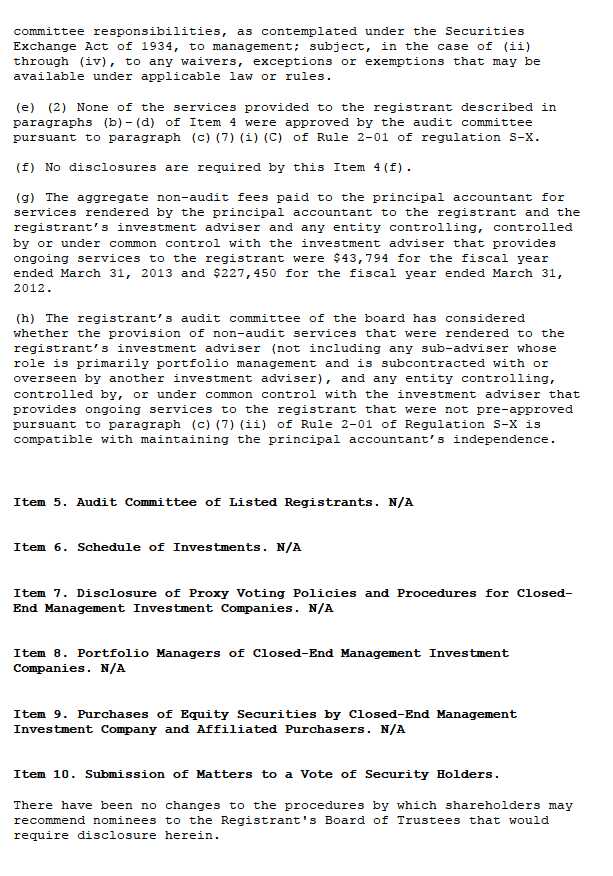
5079-4

5079-4

5079-4